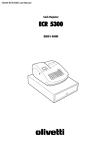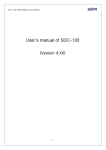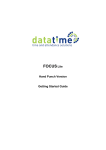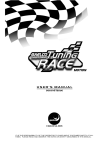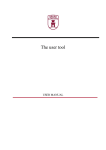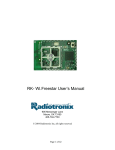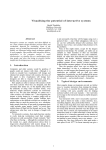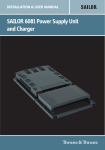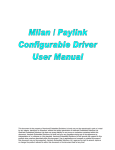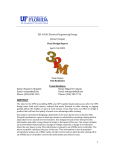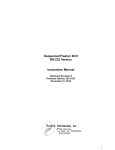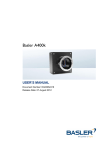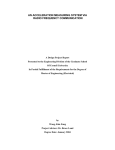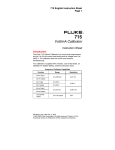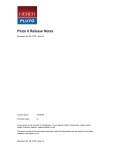Download Azkoyen Bill Hopper
Transcript
BILLHOPPER TECHNICAL INFORMATION AZKOYEN Medios de Pago, S.A Avda. San Silvestre, s/n 31350 Peralta (Navarra) Spain Tel.: +34 948 709 709 Fax: +34 948 709 709 www.azkoyen.com INDEX OF CONTENTS 1 INTRODUCTION 4 2 GENERAL DESCRIPTION 5 3 2.1 DESCRIPTION OF THE RANGE 6 2.2 RANGE OF NOTES 6 2.3 INDICATIONS OF THE LEDS – VISUAL SIGNALS 6 2.4 SPEED OF ACCEPTANCE AND PAYOUT 7 2.5 WORKING PROTOCOLS 8 2.6 JAM-PROOF SYSTEM 8 2.7 ANTI-FISHING SYSTEM 8 TECHNICAL CHARACTERISTICS 10 3.1 POWER SUPPLY 10 3.2 WORKING CONDITIONS 10 3.3 DIMENSIONS 11 3.4 12 WIRING DIAGRAM AND PINOUT 3.4.1 Connections and Pinout 12 3.4.2 Electrical Diagram of the Billhopper CcTalk 4 13 DESCRIPTION OF COMPONENTS 14 4.1 EXTERIOR FRAME AND DOOR MOUNTING 15 4.2 NOTE INLET 15 4.3 BILLSENSOR 16 4.4 SIDE COVERS 17 4.5 LINEAL TRACK ASSEMBLY 17 4.6 FLIP TRACK ASSEMBLY 17 4.7 MOTOR OF THE FLIP TRACK ASSEMBLY 18 4.8 STORAGE DRUM-NOTE CAVITIES 19 4.9 DRUM STORAGE MOTOR AND REDUCTION GEAR 19 4.10 STORAGE COVER 20 4.11 20 CASHBOX OUTLET 4.12 CONTROL BOARD 21 5 INSTALLATION 23 6 HOW IT WORKS 26 Technical information Billhopper EN 09-2013 2 7 RECOMMENDATIONS FOR CONTROL AND USE 30 8 DIAGNOSTIC OF INCIDENTS 35 8.1 LED SIGNALS OF INCIDENTS 35 8.2 35 AUTO-TEST COMMANDS AND ERROR CODES 8.2.1 Command PERFORM SELF-CHECK (0XE8) 35 8.2.2 Test Commands of the Billhopper (0X37 – 55) 37 DIAGNOSIS AND SOLUTION OF JAMMED NOTES 38 8.3 8.3.1 Jam in lineal track assembly 39 8.3.2 Jam in flip track assembly 41 8.3.3 Jam in cashbox outlet 42 8.3.4 Jam in storage 43 9 EXAMPLES OF FIXTURE ACCESSORIES 45 9.1 EXAMPLE OF FIXTURE BRACKET 45 9.2 EXAMPLE OF CASHBOX 45 10 NORMATIVE AND CE FRAMEWORK 47 11 RETRO-FIT OF BILLSENSOR TO BILLHOPPER 48 12 MAINTENANCE AND SERVICE OPERATION 51 12.1 DISMANTLING AND ASSEMBLING 51 12.2 CLEANING THE BILLSENSOR READER 54 12.3 CLEANING THE LINEAL TRACK 55 12.4 CLEANING THE STORAGE SENSOR 57 13 USER TOOLS 58 13.1 PROGRAMMING / CLONING WITH TL20 AND HEUS 59 13.2 READING ACCOUNTING DATA AND HARDWARE TEST 60 13.3 TEST SOFTWARE: GESBILL + INTERFACE 61 14 CERTIFICATIONS 62 14.1 RoHs CERTIFICATION NORMATIVE 62 14.2 REACH CERTIFICATION NORMATIVE 63 Technical information Billhopper EN 09-2013 3 1 INTRODUCTION The Billhopper has been specially designed to pay out banknotes from different types of automatic vending machines. This document provides technical information for the Billhopper banknote payout device and provides the necessary basic information for its implementation in different types of machines. Along with this document, additional information for its deployment is supplied. This information is in the files corresponding to: • Mechanical drawings of the Billhopper (relative to the dimensions). • Mechanical drawings of the Billhopper in 3D (.iges) and its accessories. • Specifications of the CcTalk Communication (commands). Due to both its design and its high technological capabilities, the Billhopper allows its adaptation to machines with different physical requirements, voltages and operational protocols giving maximum efficiency in all cases. Furthermore, it is 100% compatible with the banknote Billsensor reader allowing retrofit actions where the machine allows. The characteristics of the communication protocol are described in the specific manual. Technical information Billhopper EN 09-2013 4 2 GENERAL DESCRIPTION A note reader is an intelligent mechanism designed for the identification, validation and admission of different types of banknotes of legal tender as well as the rejection of fraud. It works in combination with other intelligent mechanisms that it is controlled by and in which it is integrated (gaming machines, change machines, vending machines, parking payment machines, etc...). The operation of the Billhopper note readers is based on transporting the banknote through an electromechanical system powered by a motor and the analysis of the banknotes by electronic sensors. The banknotes are accepted or rejected based on readings obtained by those sensors and the orders received from the machine: • Banknotes can be stored in a drum with 10 cavities for their posterior recuperation for payout (10 banknotes of different values). • It can send banknotes to the cashbox. The system to transport the banknote is made up of a belt driven by a DC motor and rollers. The materials used for these parts have been carefully selected to ensure high reliability in the transport of the banknote and high security against possible jams. The storage of the banknotes is in a drum with 10 independent cavities that allow an individual banknote to be stored separately in each one. It is a very robust and versatile system that offers obvious advantages with respect to configuration and extraction when compared with the traditional systems like the LIFO (Last in – First Out). Analysis of banknotes is through various optical sensors whose signals are managed by a digital processor that allows you to apply security with powerful calculation algorithms. This technology ensures optimal recognition of the banknote and ensures great protection against fraud. Regarding security features such as anti-fishing, the Billhopper has two different systems; the electronic detection of the string and a mechanical system which prevents the extraction of the banknote. The combination of both is excellent to prevent this type of attempt of fraud. Technical information Billhopper EN 09-2013 5 2.1 DESCRIPTION OF THE RANGE The main differences between the different versions of the Billhopper are explained below: 1. Type of notes: Depending on the type of notes of legal tender that are to be used in each geographical area and/or application. 2. The communication protocol: the way in which the Billsensor communicates with the machine can vary (software, encryption or not, etc.) although the hardware (control board) will always be the same. Consult the specific communication protocol manual. 2.2 RANGE OF NOTES The Billhopper has been specially designed to work with the following range of €uro notes • 5, 10, 20 and 50 €uros. For applications outside the area €uro, please take into account that the maximum dimensions of eligible notes are as follows: 2.3 • Maximum width: 82 mm. • Maximum length: 149 mm. INDICATIONS OF THE LEDS – VISUAL SIGNALS The Billsensor included in the Billhopper has 5 LED diodes, 3 green in the central area and 1 red on each side which are used as interface communication with the user, they will inform and guide you to what is happening at every moment. The Billsensor reader requires the notes to be introduced in the centre of the note inlet. Technical information Billhopper EN 09-2013 6 In order to ensure an optimal recognition of banknotes, the Billsensor requires that the note be introduced in the central part of the note inlet and to ensure this, it has a mechanism for the detection of the position of the note and alignment of it that will allow it to be rejected in case of bad alignment. In these cases the reader informs the user with light signals so the user can move the note toward the central part. These indications will be used also in cases of incidents; the following figures indicate the different possible states: Flashing toward the centre: waiting for a note. Detected incorrect alignment to the right. The Billsensor indicates to the user to move the note to the left (centred). Detected incorrect alignment to the left. The Billsensor indicates to the user to move the note to the right (centred). The Billsensor is in the process of recognising and accepting the note. A note is in the inlet that has not been removed buy the user. Alternating flashing LEDs: The device is carrying out a payout sequence. Simultaneous flashing LEDs: The device has detected a jam and is Out of Order. LEDs permanently lit up: The reader has detected an error and is Out of Order. Table 1. Visual Signals 2.4 SPEED OF ACCEPTANCE AND PAYOUT The average acceptance speed is 2 seconds (this parameter will vary with the different notes). The speed of payout of 10 notes from storage will never be more than 45 seconds. Technical information Billhopper EN 09-2013 7 2.5 WORKING PROTOCOLS The Billhopper can work with the following protocols: • CcTalk • CcTalk Encrypted (Standard encryption for note readers). All protocols can be used with the same electronics, so to change from one to another it is only necessary to re-programme the device. To find out more about the communication protocols, consult the specific manuals for each protocol. 2.6 JAM-PROOF SYSTEM Special attention in the design phase has been given to avoid possible incidents related to jams. Because any device that works with paper is likely to suffer jams (printers, photocopiers, etc...) we have implemented two different types of system protection: • A proactive detection system and a solution to the jam. Due to sensors, the device knows the exact location of the note at all times. Therefore it will be able to reverse the transportation sequences and make retries to solve possible incidences of jammed notes. • In extreme cases in which the first system is not effective, it will opt for the use of a reactive system to report the origin of error to the machine and at the same time the user. Obviously, this is intended to help with the objective of minimizing the time required for the resolution of an incident. This is possible thanks to the different access points that have been created for the areas of transport and storage of the note and the simplicity of the system. 2.7 ANTI-FISHING SYSTEM The Billhopper has two different anti-fishing systems: • An electronic string detection system in the interior of the Billsensor: The electronic system is based on an optical sensor that analyzes the note canal passage. If any strange presence is detected, i.e. a string, it rejects the note being analysed. • A mechanical system that hinders the return of the note: non-linear geometry of the channel of the note hinders the return of the note once it has been admitted. The note is Technical information Billhopper EN 09-2013 8 transported in horizontal direction, until at its highest point it is then carried to the bottom, there are two different alternatives, storage or cashbox. This system includes an important physical barrier for the manual transport in the opposite direction. The combination of both systems has excellent results against this type of attempt of fraud. Technical information Billhopper EN 09-2013 9 3 3.1 TECHNICAL CHARACTERISTICS POWER SUPPLY The Billhopper is capable of working correctly in the range of voltages between 12 Vdc (10%) and 24 Vdc (+10%). ATTENTION: The equipment should be powered by a MBTS (SELV) circuit according to security protection norms UNE-EN 61558-2-6:1999. 3.2 WORKING CONDITIONS 12 Vdc - 24 Vdc (± 10%) Current on start-up (peak) 3.5 A Current on standby 400mA Current on admission/payout 1.5 A Working temperature +5ºC / +55ºC Storage temperature -10ºC / +70ºC Range of relative humidity (without condensation) 20% / 95% Table 2. Working Conditions ATTENTION: This device once installed should not be accessible to the user, being located at a minimum distance of 10 mm from any electrical or metallic parts. Technical information Billhopper EN 09-2013 10 3.3 DIMENSIONS The following figures show the dimensions (in mm) of the Billhopper and the size of the opening you need to fix it to the machine (106 x 41mm). Figure 1. Dimensions of the Billhopper Consult the dimensions the drawings that are included in the complementary information (3D files). Technical information Billhopper EN 09-2013 11 3.4 WIRING DIAGRAM AND PINOUT 3.4.1 Connections and Pinout The connections to the Billhopper machine must be with a 16-way female connector. The Billhopper uses a 16 standard pin configuration connector of 2 x 8 tracks with a 2.54 mm pitch. ATTENTION: The cable for connecting of the Billsensor must be less than 3m. The pinout of the main connector is shown below: Pin 1 2 3 4 5 6 8 9 10 11 12 13 14 15 16 CcTalk RXD1_MAQ TXD1_MAQ VDC GND IMPORTANT NOTE To work in CcTalk mode, the connector that reaches the Billsensor machine must join lines RXD1_MAQ and TXD1_MAQ (pins 1 and 5 on the connector CON1). Table 3. Pinout Main Connector (CON1) The following are the drivers used for the communication. Technical information Billhopper EN 09-2013 12 3.4.2 Electrical Diagram of the Billhopper CcTalk The following figure shows the electric diagram of the CcTalk included in the Billhopper. 5V 5V 2 R9 U12 1 5 10K 2 4 RXD1_CPU 3 1 R15 2 1 0R Q3 2 100K 1 NC7SU04 3 R14 BC817 2 TXD1_MAQ / VEND1 R17 100K 2 1 GND GND 5V GND 5V 2 3 1 2 R26 100K R28 BC817 1 2 4 2 10K 3 Q6 U13 5 RXD1_MAQ / INH1 1 TXD1_CPU NC7SU04 GND GND Figure 2. Driver CcTalk To work in CcTalk mode, the connector that reaches the Billsensor machine must join lines TXD1_MAQ and RXD1_MAQ (pins 1 and 5 of the connector CON1). Technical information Billhopper EN 09-2013 13 4 DESCRIPTION OF COMPONENTS In this chapter the different parts that make up the device and its main features will be explained in detail. Figure 3. Diagram of the Billhopper components Technical information Billhopper EN 09-2013 14 4.1 EXTERIOR FRAME AND DOOR MOUNTING The outer frame and the note inlet are elements of the reader which can be seen from outside the machine and which give access to the user. They have been designed in black to fit in with any machine design and colour scheme. Both elements, as well as aesthetic functions, must contribute to the high security so are therefore manufactured using strong plastic materials for durability. Figure 4. Outer frame and fixture components 4.2 NOTE INLET The note inlet of the Billhopper is the element in which the user introduces notes; this item is installed along with the outer frame to the door of the machine. It incorporates LEDs for lighting to be used for interface with the user. Figure 5. Note inlet Technical information Billhopper EN 09-2013 15 4.3 BILLSENSOR The note reader used in the Billhopper is the Billsensor; this reader is designed for ease of installation and maintenance and for its high performance in recognition of notes and rejection of fraud. It connects to the Billhopper with an 8-way flat ribbon cable. Figure 6. Billsensor For more detailed information on the Billsensor, you can consult its specific technical manual which is available on the Azkoyen website. The image shows the fixture element used for the assembly of the Billsensor on the Billhopper. Figure 7. Fixture assembly for the Billhopper. The Billsensor must never be disconnected from the Billhopper when it is powered. It is recommended to disconnect the connection to the machine before any maintenance and/or manipulation tasks. Technical information Billhopper EN 09-2013 16 4.4 SIDE COVERS The side covers are the supports to which the rest of the Billhopper components are fixed, for this reason they have manufactured been with designed plastics of and high resistance and durability. Figure 8. Side cover 4.5 LINEAL TRACK ASSEMBLY This is the element that carries the note from the Billsensor until the drum storage or cashbox. To do so it has two conveyor belts driven by a DC motor. It also has presence and alignment sensors to detect the transit and the position of the notes. Figure 9. Lineal track assembly 4.6 FLIP TRACK ASSEMBLY The flip track assembly is the element that directs the note into the cashbox or towards the drum storage on acceptance and which collects the notes from the drum storage for their extraction for payout. Technical information Billhopper EN 09-2013 17 It is one of the most important elements of the Billhopper; it has a DC drive motor and also incorporates note presence sensors to optimise its operation. Figure 10. Flip track assembly 4.7 The MOTOR OF THE FLIP TRACK ASSEMBLY motor which is used for the movement of the flip track assembly is a 12 VDC motor which is controlled by a control board. To adjust stopping points, a circuit board with two sensors is used to determine the exact point at every moment. Figure 11. Motor of the flip track assembly The sensor board that is used to stop the flip track assembly in the correct position consists of two barrier photocells, so that small tab on the track rotates past the barrier photocells and is then detected by a control board that will send an order for the motor to stop. Technical information Billhopper EN 09-2013 Figure 12. Detection board on the flip track assembly 18 4.8 STORAGE DRUM-NOTE CAVITIES The note storage cavities are where the notes are subsequent stored to be payments. reused It for has 10 individual cavities with the dimensions to hold any kind of note (within the previously specified margins). The flip track assembly is the element that will act on each of the individual note cavities for inserting or removing the Figure 53. Note storage cavities notes. To correctly position the storage drum in the ideal position for extraction, a motor and positioning sensor are used. Figure 14. Drum position sensors 4.9 DRUM STORAGE MOTOR AND REDUCTION GEAR The motor which is used for the movement of the note storage drum is a 12 VDC motor, which is controlled by a control board. To adjust the stopping points, a board with two sensors that determine the exact position is used. Figure 65. Storage drum motor Technical information Billhopper EN 09-2013 19 4.10 STORAGE COVER This element allows access to the storage drum for its removal and for maintenance tasks, emptying, etc. It has been designed to be a very simple system that will allow easy access when necessary. Figure 76. Storage cover 4.11 CASHBOX OUTLET This is the element that carries to notes from the flip track assembly to the outside of the Billhopper: powered motor by and the cashbox. It is the storage has rollers to transport drum the notes. Figure 87. Cashbox outlet To be able to output of the note, sensor at the end correctly detect the it has a presence of the outlet. Figure 98. Cashbox output sensor Technical information Billhopper EN 09-2013 20 4.12 The CONTROL BOARD control components board of the manages all Billhopper in combination with the Billsensor. It is connected to the electronic components and is responsible for managing them according to orders received from the machine. The diagram below shows its connections: Figure 109. Control board Technical information Billhopper EN 09-2013 21 Figure 20: Control board diagram CONNECTOR FUNCTION / DEVICE CON 700 Billsensor CON 701 BDM (factory programming) CON 702 PGA connector for programming tools CON 703 Flip track sensors CON 704 ? sensor (eccentric) CON 705 CON 706 Lineal track sensors CON 707 CON 708 Cashbox sensor CON 709 Motor encoder Technical information Billhopper EN 09-2013 22 CON 710 Storage sensor CON 711 Track motor CON 712 Storage motor CON 713 ? motor (eccentric) Table 4. Description of connectors 5 INSTALLATION To install the Billhopper into the machine, a number of important considerations should be considered: We recommend that you analyze the 3D drawings that complement this manual to perform a successful mechanical implementation of the device. If there are any doubts, please get in touch with Azkoyen. 1. The Billhopper must be installed on the inside of the machine on any of the sides of the cabinet in order to provide you with an appropriate installation to ensure correct operation. Technical information Billhopper EN 09-2013 23 The Billhopper should NOT be installed in the door of the machine. Azkoyen advises AGAINST the installation of the Billhopper in the door of the machine. 2. For fixture to the side, we recommend the use of a support bracket similar to the one described in the examples of the accessories chapter in this manual (fixture bracket mounting). 3. The note inlet of the Billhopper must be installed on the door of the machine. To ensure a proper connection between the note inlet and Billhopper, proceed as described in 3D drawings that supplement to this manual. The note inlet, by design, has a system that is able to compensate logical tolerances of the alignment between the note inlet and Billhopper on cabinet of the machine. 4. The opening you need in the door to correctly install the note inlet of the Billhopper is of 106mm x 41mm. The Billhopper must be installed on the inside of the machine on any of the sides of the cabinet and the note inlet will be installed on the door, as outlined in the present instructions manual. ATTENTION: Azkoyen is not responsible for possible incidents in operation in cases where the instructions in this manual are not respected. The following figure graphically describes the recommended mounting: Technical information Billhopper EN 09-2013 24 3 4 5 6 2 1 7 Figure 21. Description of the fixture of the Billhopper to the machine 1 Note inlet 2 Machine door 3 Machine cabinet (Side) 4 Mounting Bracket 5 Fixture pivots 6 Billhopper 7 Cashbox Technical information Billhopper EN 09-2013 Its fixture is on the door of the machine and is the only part seen from the outside of the machine. The door of the machine will have the necessary opening for the fixture of the note inlet and must be of 106mm x 41mm. The Billhopper must be fixed to the machine internally on the side of the cabinet. We recommend the use of a flexible mounting bracket that is directly attached to the side of cabinet. To anchor the Billhopper support we recommend the use of 3 pivots as shown in the image. The Billhopper (with no note inlet) shall be fixed to the machine cabinet (on one side) The use of a cashbox in the lower part of the Billhopper to store the banknotes is required. This cashbox may be attached to the same mounting bracket. 25 6 HOW IT WORKS 6.1 ACCEPTANCE OF NOTES 6.1.1 Flow diagram of acceptance of notes STANDBY Note in the inlet? 1 Hardware errors? Note inhibited? Acceptance process and transit of note 2 3 String or fishing detected? Note in drum? LED signals 6 Drum full? Mechanical rejection process Storage in drum 4 Stored in cashbox 5 STANDBY Technical information Billhopper EN 09-2013 26 6.1.2 Diagram of acceptance process INLET BILLSENSOR LINEAL TRACK FLIP TRACK ASSEMBLY 3 6 2 1 CASHBOX OUTLET 4 STORAGE DRUM ASSEMBLY 5 Figure 22. Acceptance of a note Technical information Billhopper EN 09-2013 27 6.2 PAYOUT OF NOTES 6.2.1 Flow diagram of a note payout STANDBY Note in inlet? 1 Hardware errors? Note inhibited? Acceptance process and transit of note 2 3 String or fishing? Note to storage? LED signals 6 Storage drum full? Mechanical rejection process Storage in drum 4 Stored in cashbox 5 STANDBY Technical information Billhopper EN 09-2013 28 6.2.2 Diagram of a payout INLET BILLSENSOR LINEAL TRACK FLIP TRACK ASSEMBLY 3 6 2 1 CASHBOX OUTLET 4 STORAGE ASSEMBLY 5 Figure 23. Payout of a note. Technical information Billhopper EN 09-2013 29 7 RECOMMENDATIONS FOR CONTROL AND USE The recommendations described in this document attempt to explain the optimal control methodology of the Billhopper with the objective of maximising its benefits when used in AWP machines. Some of these recommendations have been incorporated as suggestions from various operators of great prestige in this field that have done trials with the product. 7.1 INSTALLATION AND START UP For successful installation and commissioning, check the following points: 1) Follow the instructions in the user manual for performing any operation on the device. 2) Make sure that the Billhopper corresponds to the type of interface of the machine or system, i.e. communication series CcTalk or CcTalk encryption (this information is available on the information label). 3) Disconnect the machine from the mains before connecting or disconnecting the Billhopper. ATTENTION: It is very important to disconnect the Billhopper from the mains and power source to avoid damage. 4) Verify that the banknotes to be accepted match those specified in the information label, as well as their exit codes. 5) If you are using encrypted protocol you must make sure that the machine knows the appropriate encryption key (fixed key) or programme the key shown on the information label (random key). 6) Inform to machine through the programming functions of the presence of the Billhopper system and program parameters that the manufacturer has defined. 7.2 HOW TO ACHIEVE MAXIMUM PERFORMANCE 1. Multi-note device: It is very important to reuse all the notes inserted for payment. Recycling all types of notes provides a number of important advantages as described at the end of this document. Technical information Billhopper EN 09-2013 30 2. Intelligent storage. Optimization of the storage space: a. Be able to payout notes in the shortest possible time, so it is very important to store the first banknotes inserted by the user. b. Control the quantity and value of notes by trying to obtain a level of optimal compromise between device functionality and down time on machine due to empty hoppers. c. Down time of the machine will not be increased, it will be reduced. d. Allow the operator to use all the notes which are inserted in the machine in the Billhopper storage device. 3. Concept of a free cavity for a better mix combination. a. The routing of notes from the storage device to the cashbox to achieve optimal mix of notes for payouts. b. Sequence of filling the Billhopper storage cavities: i. If the Billhopper has empty cavities, it is important to fill them as soon as possible with the 10 first banknotes introduced. ii. Afterwards, the machine will optimize the mix of banknotes by sending one to the cashbox and wait for a better mix (this operation is repeated until you reach the optimal mix configuration for the user). iii. It is very important to pay out part of the payment of prizes with notes from the very first note introduced by the user. 4. Mix of storage configurable by machine / operator. a. You must be able to set the quantity of notes of each type to store (Mix of optimal storage). b. Another indirect option of definition of optimum storage could be by simply defining the amount of money required in storage, and then the machine will look for the best combination depending on the input and working with the system of a free cavity. In this way it will reach the quantity defined in the shortest possible time. 5. Admission of the €50 note: a. The €50 note is not usually used in AWP machines for various reasons: i. Current legislation does not allow. ii. Increased risk of fraud. iii. Increase in emptying of change in the machine by refunding unused credits. iv. Risk of using the AWP machine as a change machine. v. Etc… b. All these risks were previously overcome when the use of the €20 banknote and before that with the €10 was introduced. c. We consider, therefore, that you should maximize use without penalising the coin hoppers and this is now possible thanks to the use of the Billhopper: Technical information Billhopper EN 09-2013 31 i. Accept the €50 note depending on the status of the notes in storage and the status of the coins in the hoppers (the machine will decide whether or not it accepts it depending on the specific circumstances). ii. This intelligent use of the €50 note could lead to increased revenue in the same way as the use of the €20 banknote increased revenue. iii. The admission of the €50 banknotes is an added benefit in that it can be reused for the payment of prizes (payment of large prizes) maximising the potential and performance of the machine. 7.3 FEATURES TO IMPLEMENT IN THE MACHINE: HOW TO DELIVER MAXIMUM PERFORMANCE TO THE OPERATOR 1. Function to enable and test. a. Allows the operator to enable the use of the device and test its operation. b. Allows the operator define the types of the banknotes to store (all or just some). 2. Accounting function: a. Allows the operator / technician / collector to know which notes are stored inside the Billhopper (quantities and types). 3. Emptying of the Billhopper to cashbox function. a. For collection tasks. b. Auditing tasks. 4. Filling function / reloading the Billhopper with banknotes. a. After emptying Billhopper, etc… 5. Manual empty function. a. If the user empties the storage manually after a problem, etc..., it informs the machine that it has done so with this feature. 6. The function of the minimum limits in which the payment of notes is used = €40 € (e.g., variable between X and Y). a. Operator must be able to configure this parameter within a logical range. b. This range shall be subject to specific amounts in storage at any time. If you have a limited amount of one or another note, it can alter it. 7. Mix between notes / coins that will be used in the payout of prizes from a starting limit of 50% / 50% (variable percentages within a range). The machine could consider conditions such as: Technical information Billhopper EN 09-2013 32 a. Current number of notes and/or coins in machine. Depending on specific conditions (number of coins and notes), the machine may alter the range to its convenience. b. The different habits of the player should enable machine to alter the range: A player that spends an hour only entering coins, should not receive many payments in notes (or none) to continue encouraging this trend. i. Analysis of what has been inserted by the user (previous credits): to decide whether to pay more coins or banknotes. ii. Analysis of movements of the saved credits or accumulated saved prizes. There can be a mix of different payments for direct prizes and payment of prizes from saved credits. iii. Total amount of a prize: you should be able to make conditions for the mix. c. Depending on the distribution of prizes foreseen in the game, the machine can alter the mix of payments to better cope with future situations. 8. Function of Test of incidents in the Billhopper / Printer concept. a. There are different types of problems which can be identified by the Billhopper and transmitted to the machine (this, in turn, can inform the user by facilitating the resolution): i. Problems in hardware (sensors, motors, etc...). ii. Problems from jammed banknotes. b. We recommend giving maximum information to the user by differing types of problems and assisting in their resolution, e.g.: i. Open back cover and remove the jammed note. ii. On machines with TFT it could even provide instructions to help with 3D graphics. 7.4 ADVANTAGES OF A MULTI-NOTE SYSTEM. WHY THE BILLHOPPER? 1. The efficiency of the machine increases if it is able to use all types of notes that are supported. Conversely, if you only use one type, efficiency is lower and there is a risk not being able to deal with empty hoppers and also in other cases that have a negative impact on takings. 2. Deciding on a single type of note for payments is difficult. The use of different types of notes is dependant on multiple factors (geographic area, player profile, type of venue, time of the month, etc...) so it cannot be assured which is the ideal note for each situation. If we use averages, we risk giving an "average" solution without covering the extremes. • SOLUTION => USE ALL THE NOTES 3. Starting from an empty storage scenario, a multi-note device will reach the optimal working level in 3 to 4 times less time than single note devices. For this reason, the following disadvantages are identified using a single note device: Technical information Billhopper EN 09-2013 33 • • • The ways a multi-note device compensates the handicap of the additional time that a single note device needs are: i. Total value in storage is much higher in a single note device than what you need to use in a multi-note device (you need much more notes in storage). ii. Preventive refills of notes will be required in a single note device in many cases. iii. Fewer takings go to reusable storage. All these imply an increase in unusable cash in the machine with all the costs arising from this. The increase of unusable cash in the machine carries with it an increased risk of theft. 4. Associated with the previous point, we can ensure you that a multi-note system with less notes in storage can provide the same or better performance than a single note system because it is much faster at recycling. • This can favour a reduction of cash in the machine (on the condition the operator collects from the cashbox, something that can be done less frequently in a single note system). 5. The combination of payments with different types of notes can further stimulate the reintroduction of part of the prize (the lowest). 6. A non-LIFO system (Last In, First Out) system: not being a LIFO system, it is possible to adapt the payments to the specific current requirements of the machine and even the habits of the player. 7. 10 individual cavities: more security than a spool system since each cavity contains a note and in the event of any problem in any of them, it will be able to use the remaining notes. A spool system has much more risk of going totally out of order. 8. All statistical simulations indicate that 10 notes of different types are more than enough to solve the problem of empty hoppers. In addition, as described above, they provide more and better solutions than a single note system and with much fewer notes in storage. Technical information Billhopper EN 09-2013 34 8 DIAGNOSTIC OF INCIDENTS The Billhopper is composed of two devices: Billsensor, responsible for analyzing and validating to notes and to drive the Billhopper where the notes to be used for payment are stored. Through the Auto-test commands of these devices, the machine can check its status. It is advisable to implement the Auto-test command in the system to detect operating errors and alert about them to be corrected. 8.1 LED SIGNALS OF INCIDENTS The Billhopper shows, with the LEDs on the exterior, its current status. The device can inform, through light signals, the two error situations or is Out of Order status. These are described below. Flashing LEDs: The reader has detected a jam and is Out of Order. LEDs lit up permanently: The reader has detected a hardware error and is Out of Order. Table 5. Visual signal for hardware errors To know in detail what the error is or the detected anomaly, it is necessary to consult the Billhopper from a machine using Auto-test commands and later check the meaning of the fault code. 8.2 8.2.1 AUTO-TEST COMMANDS AND ERROR CODES Command PERFORM SELF-CHECK (0XE8) This command performs a hardware test (optical sensors, motors, etc.) and voltage levels. When multiple errors are detected, only one error will be sent following the priority order of the following table. After solving an error another check should be made. Below are the types of error and their corresponding parameters. Technical information Billhopper EN 09-2013 35 CODE ERROR PARAMETER 0 HOPPER UNIT OK 0 NO PARAMETERS 1 ERROR PROGRAMMING FLASH 0 NO PARAMETERS 33 VOLTAGE NOT IN REQUIRED RANGE 1 ERROR VOLTAGE < 10V 2 1 ERROR VOLTAGE > 27 V ERROR MOTOR LINEAL TRACK 37 49 ERROR MOTOR ERROR OPTIC SENSOR ERROR PARAMETER ERROR LOCATION LINEAL TRACK 2 ERROR MOTOR FLIP TRACK 3 ERROR MOTOR STORAGE 1 ERROR SENS. IN LINEAL TRACK LINEAL TRACK 2 ERROR SENS. LEFT LINEAL TRACK LINEAL TRACK 3 ERROR SENS. RIGHT LINEAL TRACK LINEAL TRACK 4 ERROR SENS. UP FLIP TRACK FLIP TRACK 5 ERROR SENS. DOWN FLIP TRACK FLIP TRACK 6 ERROR SENS. LEFT FLIP TRACK FLIP TRACK 7 ERROR SENS. RIGHT FLIP TRACK FLIP TRACK 8 ERROR SENS. 0 POS STORAGE STORAGE 9 10 ERROR SENS. POS STORAGE ERROR SENS. CASHBOX STORAGE FLIP TRACK STORAGE CASHBOX Table 6. List of error codes The following figures show the different parts of the Billhopper where the locations of the sensors with and error are (cleaning, replacement, etc. may be required) Location of the sensors in the Billhopper Sensor align note Sensors position on track Sensor cashbox Sensor IN lineal track Sensors flip track Figure 24. Location of the sensors on the Billhopper Technical information Billhopper EN 09-2013 36 Sensors on the storage drum Sensor Position 0 Storage Sensor Position Storage Figure 25. Sensors on the storage drum 8.2.2 Test Commands of the Billhopper (0X37 – 55) By using this command on the Billhopper, it will send the machine information on its status and the status of the sensors. CODE MEANING 0 Working OK 1 Error storage 2 Error cashbox 3 Out of order Table 7. List of Error codes for Billhopper It allows you to find the location of a note or other foreign object obstructing a sensor with the following bitmask. CODE NAME OF SENSOR 0b10000000 Cash box Sensor 0b01000000 Right Flip track Sensor 0b00100000 Left Flip Track Sensor 0b00001000 Right Lineal track Sensor Left Lineal Track Sensor 0b00000100 Table 8. List of sensor error codes Technical information Billhopper EN 09-2013 37 An incident on the Billhopper can affect the device in different ways. The number of incidents causing a situation of out of order which makes a technical intervention necessary has been kept to a minimum. • An incident in the mechanism for sending notes to storage will still allow the notes to be sent to the cashbox. • An incident in the mechanism for sending notes to the cashbox will still allow the notes to be sent to storage. 8.3 DIAGNOSIS AND SOLUTION OF JAMMED NOTES When a note does not finish the designated route (acceptance or payout) the Billhopper will reply to a STATUS POLL (0x13 - 19) with the JAMMED STATUS and the Jam Code (see Table) with the area of the Billhopper where the note can be found, reducing technical intervention time. CODE JAM NAME 1 JAM IN LINEAL TRACK 2 JAM IN FLIP TRACK 3 JAM IN CASHBOX OUTLET 4 JAM IN STORAGE 5 JAM IN BILLSENSOR Table 9: Jam codes The following are the steps to follow to remove the jam that has occurred. Technical information Billhopper EN 09-2013 38 8.3.1 Jam in lineal track assembly To extract a jammed note stuck in the linear track, proceed as follows: 1. Disconnect the power. 2. Open the upper cover on the Billhopper and extract the Billsensor, disconnecting the connecting loom. Figure 26. Removal of the Billsensor and its loom 3. Press the clips on the lineal track. Clip Clip Figure 27. Removing the lineal track 4. Lift the Lineal track and remove the note. Technical information Billhopper EN 09-2013 39 Figure 28. Opening the lineal track 5. Lower the track and refit the Billsensor. 6. Connect Billsensor loom to the Billhopper. 7. Connect power to the Billhopper. Technical information Billhopper EN 09-2013 40 8.3.2 Jam in flip track assembly When there is a jam in the flip track, it may be due to different causes: • The track is jammed (UP_DOWN). • Note for acceptance has not passed the sensors. • Note for payout has not reached the sensors in the lineal track. In all cases, if there is a jammed note, you should note if the flip track is up or down, i.e. if it is accepting or paying out. If after disconnecting power and connecting it again the track fails to rise, only then should you resort to the operation of raising it manually which involves dismantling part of the flip track. There is a case where you can remove the jammed note when the flip track is in the down position, which is the following: • Paying out: The note must be between the lineal track and the flip track and must be treated as a jam in the lineal track. If the flip track is up, there are different cases which are: • Acceptance of note to go to the cashbox: If the note is accessible from the cashbox area, you can remove the jam as with a cashbox jam, if it is not accessible you should treat it as a storage drum jam. • Payout jam: The note must be between the lineal track and the flip track and should be treated as a lineal track jam. Technical information Billhopper EN 09-2013 41 8.3.3 Jam in cashbox outlet For a note jammed in the cashbox outlet you should follow the steps below: 1. Disconnect the power. 2. Open the cashbox outlet cover at the back of the Billhopper Figure 29. Opening the cashbox outlet cover 3. Remove the note. 4. Connect the power. Technical information Billhopper EN 09-2013 42 8.3.4 Jam in storage The step by step recommendation is as follows: 1. Disconnect the power. 2. Open the storage drum cover as shown below. Figure 30. Opening the storage drum cover 3. Remove the storage drum Figure 31. Removing the drum Technical information Billhopper EN 09-2013 43 4. Remove all the notes in storage. 5. Replace the storage drum. 6. Replace the cover. 7. Connect the power. 8. In Test mode, send a Manually Empty Storage command to reset the Storage data info. Technical information Billhopper EN 09-2013 44 9 EXAMPLES OF FIXTURE ACCESSORIES This section describes the guidelines of examples of those components which are not included in the Billhopper but that will be necessary for the fixture of the device. Azkoyen provides this information as guideline examples to serve as a support in the implementation of the Billhopper on your machine. These products are not on sale and are not supplied. 9.1 EXAMPLE OF FIXTURE BRACKET This accessory is an example of what is needed to carry out fixture of the Billhopper to the machine. It should be placed at either side of the cabinet and have the necessary pivots for the Billhopper anchorage. Likewise, at the bottom it will have fastening elements for the cashbox for banknotes. Figure 32. Example of the mounting bracket Supplementary information (files in 3D) offers this example to serve as a reference to develop your mounting bracket. 9.2 EXAM PLE Technical information Billhopper EN 09-2013 45 OF CASHBOX This example corresponds to the part that will be used to store the banknotes which have been stored by the Billhopper and not stored in the drum. It complements the mounting bracket and will be installed on the bracket with 2 screws. In this example the cashbox has a door on the front that will allow the collection of the notes without the need to remove the cashbox from the machine. Figure 33. Example of a cashbox Supplementary information (files in 3D) offers this example to serve as a reference to develop your cashbox. Technical information Billhopper EN 09-2013 46 10 NORMATIVE AND CE FRAMEWORK Like all Azkoyen products, the Billhopper meets all EC regulations of electromagnetic compatibility and others related with security compliance of its components: 1. All materials used comply with the RoHs norms. 2. UNE-EN 61000-6-3:2007, Electromagnetic Compatibility (EMC). Part 6-3: Generic Standards. Emission standard for residential, commercial and light-industrial environments. 3. UNE-EN 61000-6-1:2007, Electromagnetic Compatibility (EMC). Part 6-1: Generic Standards. Immunity for residential, commercial and light-industrial environments. - UNE-EN 61000-4-2:1997; /A1:1999; /A2:2001; Erratum: 2004: Electromagnetic Compatibility (EMC). Part 4: Measurement and Testing Techniques. Section 2: Electrostatic discharge immunity tests. Basic EMC Publication. - UNE-EN 61000-4-3:2007, Electromagnetic Compatibility (EMC). Part 4: Measurement and Testing Techniques. Section 3: Radiated, radio-frequency, electromagnetic field immunity test. - UNE-EN 61000-4-4:2005, Electromagnetic Compatibility (EMC). Part 4: Measurement and Testing Techniques. Section 4: Electrical fast transient/burst immunity test. Basic EMC Publication. - UNE-EN 61000-4-6:1998; /A1:2001, Electromagnetic Compatibility (EMC). Part 4: Measurement and Testing Techniques. Section 6: Immunity to conducted disturbances, induced by radio-frequency fields. - UNE-EN 61000-4-8:1996; /A1:2001, Electromagnetic Compatibility (EMC). Part 4: Measurement and Testing Techniques. Section 8: Power frequency magnetic field immunity test. EMC Basic Standard. 4. UNE-EN 60950-1:2007, /A11:12009, /Corr: 2007, Information technology equipment – Safety – Part1-General requirements. Technical information Billhopper EN 09-2013 47 11 RETRO-FIT OF BILLSENSOR TO BILLHOPPER If the machine software allows and mechanically possible, there is the possibility of making a retro-Fit of Billsensor to Billhopper on machines not incorporating the recycler capacity. Take into account the following: 11.1 STARTING WITH THE BILLSENSOR NOTE INLET Figure 34. Note Inlet for the Billsensor Material that the machine with a Billsensor has: 1 Front plate 2 screws: M4x40 2 holding plates 4 washers 4.3 DIN6798 6 nuts M4 (2 recommended) 1 note inlet for the Billsensor The opening in the door of the machine (106x41mm) is the same used for Billhopper Note Inlet. Fixing the Note Inlet of the Billsensor: Technical information Billhopper EN 09-2013 48 1. First place the front plate with the two screws on the door of the machine. 2. Assemble the two plates of the front plate fixture and fasten them with 2 washers and 2 nuts. 3. Fit the other 2 nuts to regulate the height depending on the thickness of the door (recommended) 4. Place the Billsensor note inlet assembly. 5. Finally mount the other 2 washers and 2 nuts to hold the Note Inlet. 11.2 SUBSTITUTION OF THE BILLSENSOR NOTE INLET FOR THE BILLHOPPER NOTE INLET Figure 35. Note Inlet for the Billhopper Parts necessary for fitting the Note Inlet of the Billhopper: 1 front plate 2 screws: M4x40 2 front plate holding plates 4 washers: 4.3 DIN6798 4 nuts: M4 1 Billsensor note inlet 2 note inlet clips Fitting the Billhopper Note Inlet: Technical information Billhopper EN 09-2013 49 1. First remove the 2 washers and 2 nuts. 2. Remove the Billsensor note inlet. 3. Remove the 2 nuts for regulating the height. 4. Fit the Billhopper note inlet. 5. Fit the 2 notes inlet clips. 6. Finally fit the other 2 washers and 2 nuts. Technical information Billhopper EN 09-2013 50 12 MAINTENANCE AND SERVICE OPERATION The following describes the maintenance and cleaning procedures and the corresponding dismantling and assembly processes needed to carry them out. 12.1 DISMANTLING AND ASSEMBLING For any technical intervention of maintenance or cleaning, it will be necessary to follow the instructions below: For this operation you will need: • Philips screwdriver with a PH1 or PH2 head. ATTENTION: Before connecting or disconnecting the Billhopper you should make sure that the machine has been disconnected from the mains power supply to avoid any electrical damage. 1. Disconnect the loom that goes to the machine to the Billhopper. Technical information Billhopper EN 09-2013 2. Remove the Billhopper from the machine to facilitate access to all its parts in a faster and more comfortable way. 51 A 2. To open the upper cover: Pull the clip backwards (A) at the same time as lifting up the cover. (B) B 3. Once opened we have access to the control board on the Billhopper and other internal components. 4. The next step is to disconnect the loom that goes from the Billsensor to the Billhopper (C). C 5. Once disconnected, you can remove the Billsensor from the Billhopper the following way: Press the clip on the lower part of the Billsensor to the right. (D) D Pull the Billsensor outwards. (E) E Technical information Billhopper EN 09-2013 52 6. Once you have Billsensor, you have internal parts for removed access the to maintenance its and cleaning tasks. 7. To remove the lower cover, press the lower clip (F) and lightly pull the cover backwards by pressing on the front part (G). F G 8. To finalise the removal of the cover, press on the sensor (H) moving the upper H front cover towards you. 9. Once you have removed the cover, you have access to all the internal parts of the Billsensor. Figure 36. Dismantling and Assembly 10. On separating the two halve of the chassis, it is only connected with affine ribbon cable. Handle with great care to avoid damage. Technical information Billhopper EN 09-2013 53 The procedure for the Assembly is the opposite of that described above. Check that clips are firmly closed. 12.2 CLEANING THE BILLSENSOR READER For this operation you will need: • Compressed air or an aerosol. • Alcohol (Isopropyl alcohol is recommended for cleaning optical devices and electronic circuits). • A soft lint-free cloth. The maintenance that the Billsensor requires is as follows: A general cleaning of the reader every 5000 acceptances of notes. The first step is to dismantle the unit from the Billhopper, see 12.1 DISMANTLING AND ASSEMBLING. Then we recommend using compressed air or an aerosol to eliminate the dust and particles that may be trapped in the note channel (there are aerosol cans readily available for this cleaning operation). For a final cleaning of the two parts, we recommend the use of a soft cloth dampened with cleaning alcohol (it is not necessary to dilute with water). o Isopropyl alcohol is recommended for cleaning optical devices and electronic circuits. Technical information Billhopper EN 09-2013 54 Figure 37. Areas that should be cleaned ATTENTION: Do not use products containing benzenes. These products produce a rapid degradation of the plastics causing irreparable damage. Do not use alcohols other than specified in the instructions. Do not submerge the Billsensor in any type of liquid. 12.3 CLEANING THE LINEAL TRACK As with the note reader, regular cleaning is recommended for the lineal track assembly. This may be done at the same time as the cleaning of the Billsensor. For this operation you will need: • Compressed air or an aerosol. • Alcohol (Isopropyl alcohol is recommended for cleaning optical devices and electronic circuits). • A soft lint-free cloth. The necessary steps for this cleaning are described below: Technical information Billhopper EN 09-2013 55 The first step is to dismantle the unit from the Billhopper, see 12.1 DISMANTLING AND ASSEMBLING. Then follow the instructions in chapter 8.3.1 until step 6 to remove the lineal track assembly. Next open the lineal track assembly as indicated in the diagram below to be able to access the optic sensors. We recommend using compressed air or an aerosol to eliminate the dust and particles that may be trapped in the note channel and on the optic sensors and then clean the two parts with a soft cloth dampened with isopropyl alcohol. Figure 38. Opening the track. Figure 39. Areas to be cleaned on the lower part Figure 40. Areas to be cleaned on the upper part Technical information Billhopper EN 09-2013 56 12.4 CLEANING THE STORAGE SENSOR It is recommended to clean the storage sensor every 10,000 services. To access it, there is a rear cover of storage area at the back of the Billhopper. Perform the cleaning of the reflective sensor using air pressure and a soft cloth with isopropyl alcohol. For this operation you will need: • Compressed air or an aerosol. • Alcohol (Isopropyl alcohol is recommended for cleaning optical devices and electronic circuits). • A soft lint-free cloth. Figure 41. Rear cover for access to the storage sensor Technical information Billhopper EN 09-2013 57 13 USER TOOLS The Billsensor uses a microcontroller with flash memory that makes it possible to update the software through the use of Azkoyen tools designed for this purpose. This function will be needed when there are updates to a note data file or when you want to use the reader for a different Protocol than it has been configured in the factory. The difference between programming and cloning is the origin of a data, for the programming use files that have been downloaded from the web or e-mail and to do a cloning you use files that have been read from another Billsensor. The procedure for both operations is described graphically below: Web / e-mail CLONING PROGRAMMING ORIGIN OF THE FILE Updated Billsensor DIFFERENT VARIABLES + HEUS + DEVICE + HEUS Figure 42. Programming and cloning Technical information Billhopper EN 09-2013 58 13.1 PROGRAMMING / CLONING WITH TL20 AND HEUS The TL20 is a programming and/or cloning device designed and manufactured by Azkoyen which is used to update files of different products with new versions that have been previously stored in its memory. It is a user friendly tool that is used together with the software user tool programme HEUS or alone for programming or cloning tasks. Figure 43. TL20 The operation of these devices can be summarized by the following: - The user should get updated files for the Billsensor from the website, via email or by reading them from another updated Billsensor. - Then following instructions for using the tool TL20, you must connect the Billsensor through the 4-pin connector and update it with a new version. There is a specific manual, for both the TL20 and the HEUS, available on the Azkoyen website http://sat.azkoyen.com that you should refer to for instructions on use and the operation in detail of these devices. HEUS is a free software management tool for Azkoyen products and can be found on the Azkoyen website: http://sat.azkoyen.com Technical information Billhopper EN 09-2013 59 13.2 READING ACCOUNTING DATA AND HARDWARE TEST The Billsensor is capable of storing two accounting records in its memory: • Absolute accounting: It keeps perpetual accounting records from the first day of operation. • Partial accounting: It keeps records from a last time was reset and it is possible to delete it at any time with a HEUS + Cable or through TL20. Figure 44. Examples of Accounting in HEUS. It is possible to save different records and different readings, as well as export them to Excel for statistical reports. Other HeUs software applications allow you to test the Billsensor hardware, being able to identify possible errors in its internal components (sensors, motor, etc.) The internal accounting can be used as an element of security, analyzing that they match the machine accounting. Also useful to verify the percentages of acceptance of each type of note in a situations that there are claims of high rejection. Technical information Billhopper EN 09-2013 60 13.3 TEST SOFTWARE: GESBILL + INTERFACE To perform functional tests with the Billhopper through a PC there is specific software called GESBILL: Figure 45. Software GESBILL This software will require the particular interface depending on the Protocol: • Interface USB-Cctalk GESBILL is software that simulates the Billsensor communication with a machine. It is free and can be found on the Azkoyen website http://sat.azkoyen.com Technical information Billhopper EN 09-2013 61 14 CERTIFICATIONS 14.1 RoHs CERTIFICATION NORMATIVE Technical information Billhopper EN 09-2013 62 14.2 REACH CERTIFICATION NORMATIVE Technical information Billhopper EN 09-2013 63































































